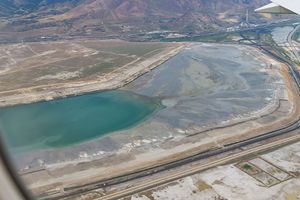Tailings pond

Tailings ponds are one of the methods used to store tailings, the waste material left over from ore extraction processes. Tailings are often mixed with water to create a slurry, which is easier to transport.[2] One method of storing the slurry is in tailings ponds (Figure 1). Depending on the design of the pond, this may or may not also include the use of a tailings dam (which is often partially built or re-inforced using tailings that have dried out). Ponds can be used for long term storage, as a place to allow the different components of the tailings to settle out of suspension, or for temporary holding until for the tailings can be further processed.[3] The composition of the tailings will determine which way the pond is used. Different types of mines produce different types of tailings. For example, the tailings produced by a nickel mine will be quite different from the tailings produced by an oil sands mine.
Environmental Concerns

Before the environmental harm that tailings are capable of causing was properly understood, many companies simply discharged tailings slurries into nearby water sources (rivers, lakes, bays. See Figure 2). As people came to better understand the impacts this was having on the environment, regulations and laws were put in place to minimize the damage that tailings cause.[5]. The major concern with tailings ponds is the potential for leaks. This is most likely to happen to improperly designed ponds or older ponds that have been in use for a long time (and did not have modern techniques used in their design). Occasionally, natural events, such as seismic events or extreme weather (e.g. hurricanes or tornados) can cause leaks to develop in otherwise sound designs. Leaks allow for toxic substances contained in the tailings ponds to leach into the surrounding environment, harming habitats, wildlife, and potentially even people. Constant monitoring and maintenance are needed to ensure that no leaks occur.[6]
Reclamation
Reclamation is the process of returning an area to as close to its original state (before mining) as possible. Each tailings pond uses a unique combination of reclamation techniques to complete the process. The types of techniques utilized are based on the type of tailings in the pond and what the environment was previously like in that location. Some of the techniques include the use of microbes to breakdown parts of the tailings, phytostabilization (the use of plants to help stabilize the tailings), or the re-processing the tailings to further remove desirable (or harmful, if possible) substances from them. The general steps of reclamation for tailings ponds are treatment or neutralization of the harmful elements, removal of any substances that could be reused for other things, the burial of any remaining substances, and finally the restoration of the surface environment (planting trees, re-introducing animals, etc).[6] Tailings pond reclamation is a long process that needs to be monitored continuously, even after the initial reclamation is completed.[7]
For Further Reading
References
- ↑ Wikimedia Commons. (Sept 26, 2019). File:Kennecott Tailings Pond and Smokestack.jpg [Online]. Available: https://commons.wikimedia.org/wiki/File:Kennecott_Tailings_Pond_and_Smokestack.jpg
- ↑ Jon Engels, Tailings.Info. (Sept 27, 2019). What are Tailings [Online]. Available: http://www.tailings.info/basics/tailings.htm
- ↑ Edraki, Mansour, et al. "Designing mine tailings for better environmental, social and economic outcomes: a review of alternative approaches." Journal of Cleaner Production 84 (2014): 411-420. (Accessed Sept 27, 2019). https://doi.org/10.1016/j.jclepro.2014.04.079
- ↑ Wikimedia Commons. (Sept 26, 2019). File:SOUTHWESTERLY CURRENTS HAVE CARRIED TACONITE TAILINGS DISCHARGED BY RESERVE MINING COMPANY'S PLANT IN SILVER BAY, TO... - NARA - 551575.jpg [Online]. Available: https://commons.wikimedia.org/wiki/File:SOUTHWESTERLY_CURRENTS_HAVE_CARRIED_TACONITE_TAILINGS_DISCHARGED_BY_RESERVE_MINING_COMPANY%27S_PLANT_IN_SILVER_BAY,_TO..._-_NARA_-_551575.jpg
- ↑ Alberta Energy. (Sept 27, 2019). Tailings Timeline [Online]. Available: https://www.aer.ca/providing-information/by-topic/tailings/tailings-timeline
- ↑ 6.0 6.1 Hossner, L. R., and F. M. Hons. "Reclamation of mine tailings." Soil Restoration. Springer, New York, NY, 1992. 311-350.
- ↑ Canada's Oil Sands. (Accessed Sept. 27, 2018). Tailings Ponds [Online]. This was available at: canadasoilsands.ca/en/explore-topics/tailings-ponds but that resource has now been combined with an oil lobbying group, the Canadian Association of Petroleum Producers.

